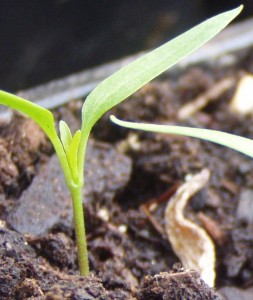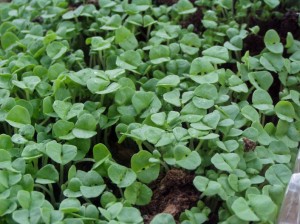Since it is literally in the low 40s outside, and raining, and generally miserable (we don’t call this place Che Siberia for nuthin’ folks), your Aunt Toby is forced to working inside today to get whatever can get done, done, so that when the weather improves, which it will eventually, we are ready to go.
This week has not exactly been a barn-burner in terms of good weather either, so even with plastic on the garden bed, it has not gotten above 49 degrees F. That means I can’t put in my seeds for the early spring crops like kale, lettuce, broccoli, cauliflower, chard and beets. Boo, hiss. Super annoying. If we could just catch a break and get a couple of warm, sunny days, that garden bed would warm up. Just..one…more…degree..of…warmth…in the soil will do it. Hope, as they say, springs eternal.
 In the greenhouse, even though it is a bit chilly, things are moving along pretty well. I continue to be impressed by heritage pepper ‘King of the North’, given that these seedlings are in an unheated (and rather chilly this past week) greenhouse. They continue to grow and do not seem to be effected by the rather negative growing conditions. Tough guys for sure. The plum tomatoes soldier on as well. In the mail this week, I received the potatoes and onion plants that I ordered from Territorial Seeds. The potatoes are one we have grown in the past which have dealt with our rather iffy conditions and negligent care rather well — German Butterball and the onion plants are a mixed bunch chosen for northern areas (always important when dealing with day length and night time temperature issues).
In the greenhouse, even though it is a bit chilly, things are moving along pretty well. I continue to be impressed by heritage pepper ‘King of the North’, given that these seedlings are in an unheated (and rather chilly this past week) greenhouse. They continue to grow and do not seem to be effected by the rather negative growing conditions. Tough guys for sure. The plum tomatoes soldier on as well. In the mail this week, I received the potatoes and onion plants that I ordered from Territorial Seeds. The potatoes are one we have grown in the past which have dealt with our rather iffy conditions and negligent care rather well — German Butterball and the onion plants are a mixed bunch chosen for northern areas (always important when dealing with day length and night time temperature issues).
And, from the ‘never say never’ school of thinking: I was out in the greenhouse with our 16 month old grand-progeny for a little gardening fun (that kid will water anything that appears to be in a pot), and put out a salad tub with potting soil in it so that we could plant a few basil seeds. I handed her an old packet, thinking a) there were not many in it and b) they were OLD so no matter how many she scattered in the tub, I figured that germination would not be all that bad and we’d end up with a few.
 This is what happens when you have a 16 month old child whose idea of ‘planting a few seeds’ consists of flinging her arm out and dumping the entire packet (which turned out to have a LOT of seeds in it)in the tub. Anyone need basil seedlings? I think I might have enough for..everyone.
This is what happens when you have a 16 month old child whose idea of ‘planting a few seeds’ consists of flinging her arm out and dumping the entire packet (which turned out to have a LOT of seeds in it)in the tub. Anyone need basil seedlings? I think I might have enough for..everyone.
What do I grow? For those folks who feel a bit overwhelmed by choices (and goodness knows there are a huge buffet of choices out there) in their gardens, let me suggest one guideline that might narrow things a bit: The Environmental Working Group’s list of ‘the dirty dozen.” This list of fruits and veggies consist of their results of testing standard fruits and vegetables bought in standard US grocery stores to find which ones have the highest levels of pesticide residues on them. Now, the issue is that standard US kitchen sink washing methods do not do a very good job of removing pesticide residues, so their suggestion is that if you have a limited food budget, that you make sure that these items are the ones you spend your ‘organic food dollars’ on. Here’s the list:
Apples
Celery
Cherry Tomatoes
Cucumbers
Grapes
Sweet and hot peppers
Imported Nectarines
Peaches
Potatoes
Spinach
Strawberries
Kale and collard greens
Summer Squashes
EWG Dirty Dozen Plus
Now, ok, if we are not going to go to the trouble of putting in trees and vines to grow apples, grapes, peaches and nectarines organically (growing strawberries at home is something that is worth getting into, along with asparagus and rhubarb), we can grow the other things and actually quite easily (and that includes celery, which is wonderful straight out of the garden). So, if you want to get a twofer out of your garden – make sure you grow the stuff on this list organically. A lot of these can be grown EASILY with organic methods – and if you are super lazy the way we are here, that includes ROW COVERS (which basically prevent bugs from getting to your veggies to eat them or lay their eggs). You can go full-on with hoops over the beds, but it’s just as effective to just lay the spun polyester (or old sheer curtains if you have them or can get them) over the plants and tuck them into the soil at the edge of the row. This is something you can find at any home and garden center or big-box store in their garden department.
